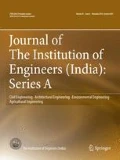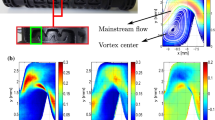Abstract
Certain types of soil fail to absorb larger discharge causing excess water to go waste. Higher flow rate tends to carry the sandy soil along with it, making it useless and damaging to the crop. To address these problems, drip irrigation method with labyrinth channel emitters is used to optimize the amount of water used. Emitters with lower rate of flow are more desirable and efficient. These save water and fertilizer by dripping water slowly and uniformly as per the requirement of the roots of plants, either to the soil surface or directly to the root zone. In this study, visualization of the flow characteristics of 3-D emitters with different types of in-line labyrinth channels is done with the help of principles of computational fluid dynamics (CFD). Commercial CAD software SolidWorks is used for modeling the 3-D geometry of the emitter, and ANSYS FLUENT is used for CFD analysis. A comparative study of different turbulence models is carried out in order to find the most suitable model for the problem. Discharge is calculated at ten different operating inlet pressures in terms of head of water. The emitter of four different channel profiles: circular, rectangular, triangular and trapezoidal, is studied. The triangular channel has the lowest pressure drop (15.94 kPa) as compared to other channels. Based on simulated discharge values, the triangular channel has the lowest discharge as compared to other channels.















Similar content being viewed by others
References
A.I. Al-Amoud, Significance of energy losses due to emitter connections in trickle irrigation lines. J. Agric. Eng. Res. 60(1), 1–5 (1995)
V. Bagarello, V. Ferro, G. Provenzano, D. Pumo, Evaluating pressure losses in drip-irrigation lines. J. Irrig. Drain. Eng. 123(1), 1–7 (1997)
J.D. Valiantzas, Analytical approach for direct drip lateral hydraulic calculation. J. Irrig. Drain. Eng. 124(6), 300–305 (1998)
Q. Wei, Y. Shi, W. Dong, G. Lu, S. Huang, Study on hydraulic performance of drip emitters by computational fluid dynamics. Agric. Water Manag. 84(1), 130–136 (2006)
Y.K. Li, P.L. Yang, S.M. Ren, T.W. Xu, Hydraulic characterizations of tortuous flow in path drip irrigation emitter. J. Hydrodyn. 18(4), 449–457 (2006)
J. Zhang, W. Zhao, Z. Wei, Y. Tang, B. Lu, Numerical and experimental study on hydraulic performance of emitters with arc labyrinth channels. Comput. Electron. Agric. 56(2), 120–129 (2007)
W. Qingsong, L. Gang, L. Jie, S. Yusheng, D. Wenchu, H. Shuhuai, Evaluations of emitter clogging in drip irrigation by two-phase flow simulations and laboratory experiments. Comput. Electron. Agric. 63(2), 294–303 (2008)
H.S. Liu, Y.K. Li, Y.Z. Liu, P.L. Yang, S.M. Ren, R.J. Wei, H.B. Xu, Flow characteristics in energy dissipation units of labyrinth path in the drip irrigation emitters with DPIV technology. J. Hydrodyn. 22(1), 137–145 (2009)
J. Zhang, W. Zhao, Y. Tang, B. Lu, Anti-clogging performance evaluation and parameterized design of emitters with labyrinth channels. Comput. Electron. Agric. 74, 59–65 (2010)
H.K. Celik, D. Karayel, N. Caglayan, A.E. Rennie, I. Akinci, Rapid prototyping and flow simulation applications in design of agricultural irrigation equipment: case study for a sample in-line drip emitter: the paper is to study CFD and RP application samples on the design issues associated with agricultural irrigation equipment. Virtual Phys. Prototyp. 6(1), 47–56 (2011)
D. Wu, Y.K. Li, H.S. Liu, P.L. Yang, H.S. Sun, Y.Z. Liu, Simulation of the flow characteristics of a drip irrigation emitter with large eddy methods. Math. Comput. Model. 58(3), 497–506 (2013)
H. Yurdem, V. Demir, A. Mancuhan, Development of a simplified model for predicting the optimum lengths of drip irrigation laterals with coextruded cylindrical in-line emitters. Biosyst. Eng. 137, 22–35 (2015)
L. Zhang, P.T. Wu, D.L. Zhu, C. Zheng, Flow regime and head loss in a drip emitter equipped with a labyrinth channel. J. Hydrodyn. 28(4), 610–616 (2016)
L. Guo, D. Bai, X. Wang, J. He, W. Zhou, P. Cheng, Hydraulic performance and energy dissipation effect of two-ways mixed flow emitter in drip irrigation. Trans. Chin. Soc. Agric. Eng. 32(17), 77–82 (2016)
L. Guo, D. Bai, X. Wang, J. He, W. Zhou, P. Cheng, Numerical simulation and verification of hydraulic performance and energy dissipation mechanism of two-ways mixed flow emitter. Trans. Chin. Soc. Agric. Eng. 33(14), 100–107 (2017)
T. Xu, L. Zhang, Hydraulic performance and energy dissipation effect of pit structure flow emitter. IFAC-Papers OnLine 52(30), 143–148 (2019)
V. Demir, H.U. Yurdem, A. Yazgi, T.U. Gunhan, Measurement and prediction of total friction losses in drip irrigation laterals with cylindrical integrated in-line drip emitters using CFD analysis method. J. Agric. Sci. 25(3), 354–366 (2019)
R.B. Zanca, F.D. Silva, D.O. SantAnna, A.T. Silva, H.F. Nova, I.F. Santos, J.A. Reis, Modeling and hydraulic performance evaluation of a dripper device coupled to a branched water distribution network. Rev. Ambiente Agua 14(3), e2340 (2019)
V. Demir, H. Yurdem, A. Yazgi, T. Gunhan, Determination of the hydraulic properties of a flat type drip emitter using computational fluid dynamics. J. Agric. Sci. 26(2), 226–235 (2019)
T. Xu, L. Zhang, Influence and analysis of structure design and optimization on the performance of a pit drip irrigation emitter. Irrig. Drain. 69(4), 633–645 (2020)
W. Zhou, L. Zhang, P. Wu, Y. Cai, X. Zhao, C. Yao, Hydraulic performance and parameter optimisation of a microporous ceramic emitter using computational fluid dynamics, artificial neural network and multi-objective genetic algorithm. Biosyst. Eng. 189, 11–23 (2020)
J. Feng, Y. Li, W. Wang, S. Xue, Effect of optimization forms of flow path on emitter hydraulic and anti-clogging performance in drip irrigation system. Irrig. Sci. 36(1), 37–47 (2018)
W. Zhao, J. Zhang, Y. Tang, Z. Wei, B. Lu, Research on transitional flow characteristic of labyrinth channel emitter. International Federation for Information Processing (IFIP) 294. Comput. Comput. Technol. Agric. II(2), 881–890 (2009)
Author information
Authors and Affiliations
Corresponding author
Additional information
Publisher's Note
Springer Nature remains neutral with regard to jurisdictional claims in published maps and institutional affiliations.
Rights and permissions
About this article
Cite this article
Baghel, Y.K., Kumar, J. & Patel, V.K. CFD Analysis of the Flow Characteristics of In-Line Drip Emitter with Different Labyrinth Channels. J. Inst. Eng. India Ser. A 102, 111–119 (2021). https://doi.org/10.1007/s40030-020-00499-5
Received:
Accepted:
Published:
Issue Date:
DOI: https://doi.org/10.1007/s40030-020-00499-5




